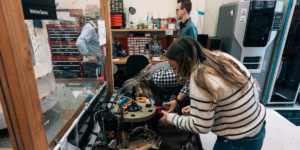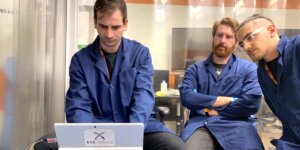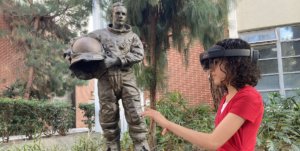
USC president C. L. Max Nikias stands next to U.S. Rep. Jerry Lewis from California~s 41st district, along with other members of a delegation from USC.
A USC delegation led by President C.L. Max Nikias and Provost Elizabeth Garrett recently called on two California legislators to thank them for their support of space research involving ISI students.
During his mid-March visit to Washington D.C., Nikias presented U.S. Representative Jerry Lewis and Senator Diane Feinstein personal letters of gratitude, along with collections of photographs and graphics documenting the work by the Information Sciences Institute and the USC Space Engineering Research Center (SERC) to build “nanosatellites” that they have supported.
This continuing project is a joint effort between USC, Northrop Grumman’s NOVAWORKS division and other companies. ISI/SERC supplied one of the eight nanosatellite units put into orbit December 8 in a SPACE X launch from Cape Canaveral.
ISI Students and researchers built the unit, named CAERUS after the Greek god of opportunity. The CAERUS team included David Barnhart, who originated space projects at ISI, and Senior Design Engineer Tim Barrett; industry professionals Jeff Sachs, Michael Aherne and John Smolik; and students, Lucy Hoag, Emin Vartanians, Melissa Jawaharlal, John Razzano, Omair Rahman, Rahul Karkhanis, Eric Teegarden, Sara Gramling, Carson Vogt, Amparo Romero, Maria Guzman, Neha Rathore, Chunyih Chu,and Dayung Koh.
Working with the USC Department of Astronautical Engineering and other departments at the Viterbi School, the team delivered CAERUS just fourteen weeks after receiving authorization to proceed on the project.
Professors Joseph Kunc and Daniel Erwin led the campus teams from the Department of Astronautical Engineering and the SERC. A joint effort between Astronautics and ISI, the SERC’s expertise and student involvement provided critical support for the rapid ground-station development timeline.
The SERC follows an Engineering “Teaching Hospital” model where industry professionals, graduate students, and undergrads serve as doctors, residents, and med students respectively.
The material Nikias presented to Lewis and Feinstein showed the students in the laboratory at work on the vehicle, along with background information on the projects.
According to one USC witness, “the Chairman also liked the [progress report package] and said he would be interested in visiting the campus… They also had a good discussion about the importance of aerospace education.”
Jennifer Grodsky, Executive Director of the USC Office of Federal Relations, said that Senator Feinstein “greatly appreciated the folder Max handed her,” containing the letter and documentation.
Launch of a second USC/ISI satellite, to be named Aeneas, will take place in mid 2012.
Published on March 29th, 2011
Last updated on August 5th, 2021












